cruise control BMW 535I GT 2011 F07 Owner's Manual
[x] Cancel search | Manufacturer: BMW, Model Year: 2011, Model line: 535I GT, Model: BMW 535I GT 2011 F07Pages: 297, PDF Size: 8.59 MB
Page 13 of 297
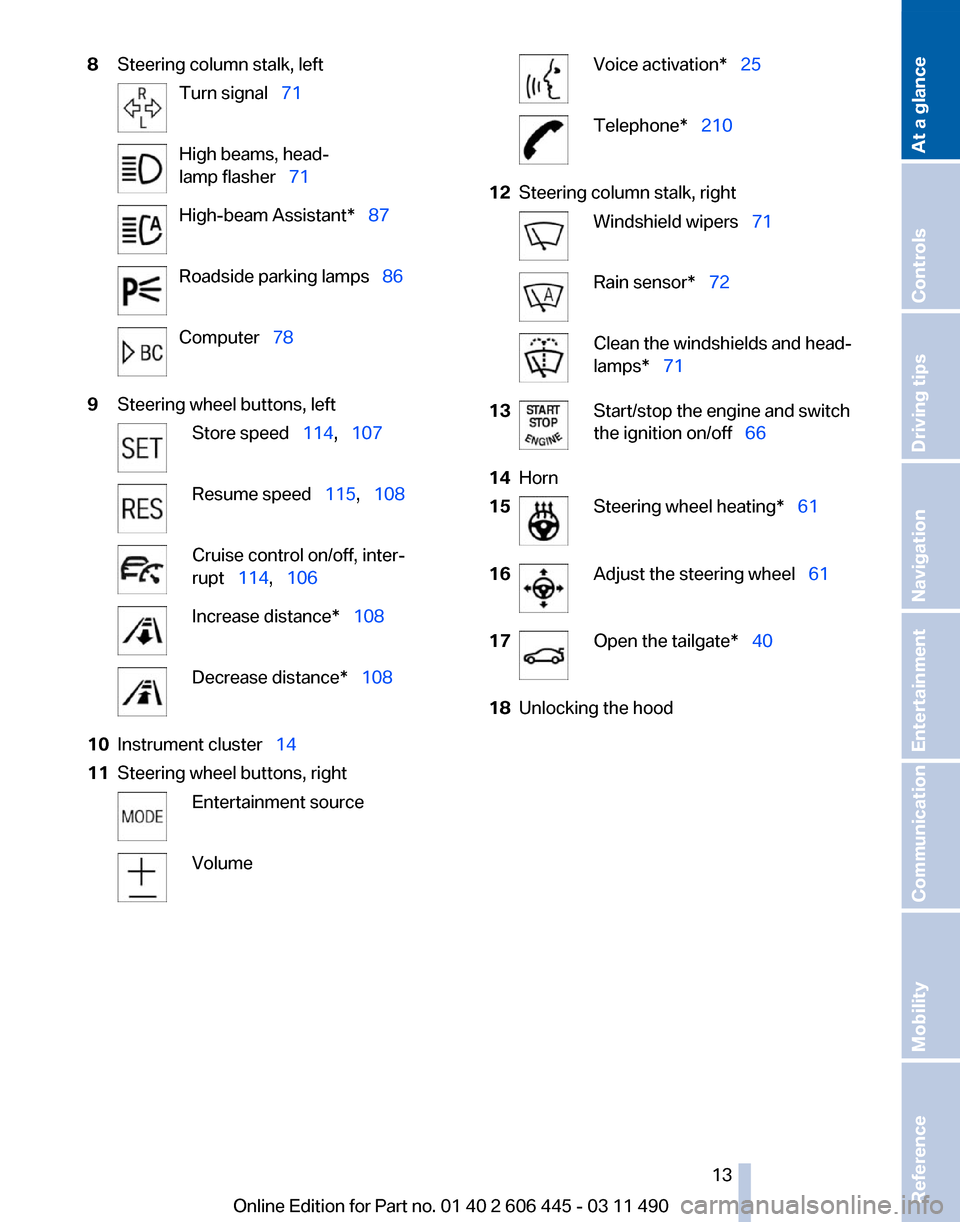
8
Steering column stalk, left Turn signalтАВтАЕ71
High beams, headтАР
lamp flasherтАВтАЕ71
High-beam Assistant*тАВтАЕ87
Roadside parking lampsтАВтАЕ86
ComputerтАВтАЕ78
9 Steering wheel buttons, left Store speedтАВтАЕ114,тАВтАЕ107
Resume speedтАВтАЕ115,тАВтАЕ108
Cruise control on/off, interтАР
ruptтАВтАЕ114,тАВтАЕ106
Increase distance*тАВтАЕ108
Decrease distance*тАВтАЕ108
10 Instrument clusterтАВтАЕ 14
11 Steering wheel buttons, right Entertainment source
Volume Voice activation*тАВтАЕ25
Telephone*тАВтАЕ210
12 Steering column stalk, right Windshield wipersтАВтАЕ71
Rain sensor*тАВтАЕ
72 Clean the windshields and headтАР
lamps*тАВтАЕ71
13 Start/stop the engine and switch
the ignition on/offтАВтАЕ66
14 Horn
15 Steering wheel heating*тАВтАЕ61
16 Adjust the steering wheelтАВтАЕ
61
17 Open the tailgate*тАВтАЕ40
18 Unlocking the hood
Seite 13
13Online Edition for Part no. 01 40 2 606 445 - 03 11 490
Reference Mobility Communication Entertainment Navigation Driving tips Controls
At a glance
Page 15 of 297
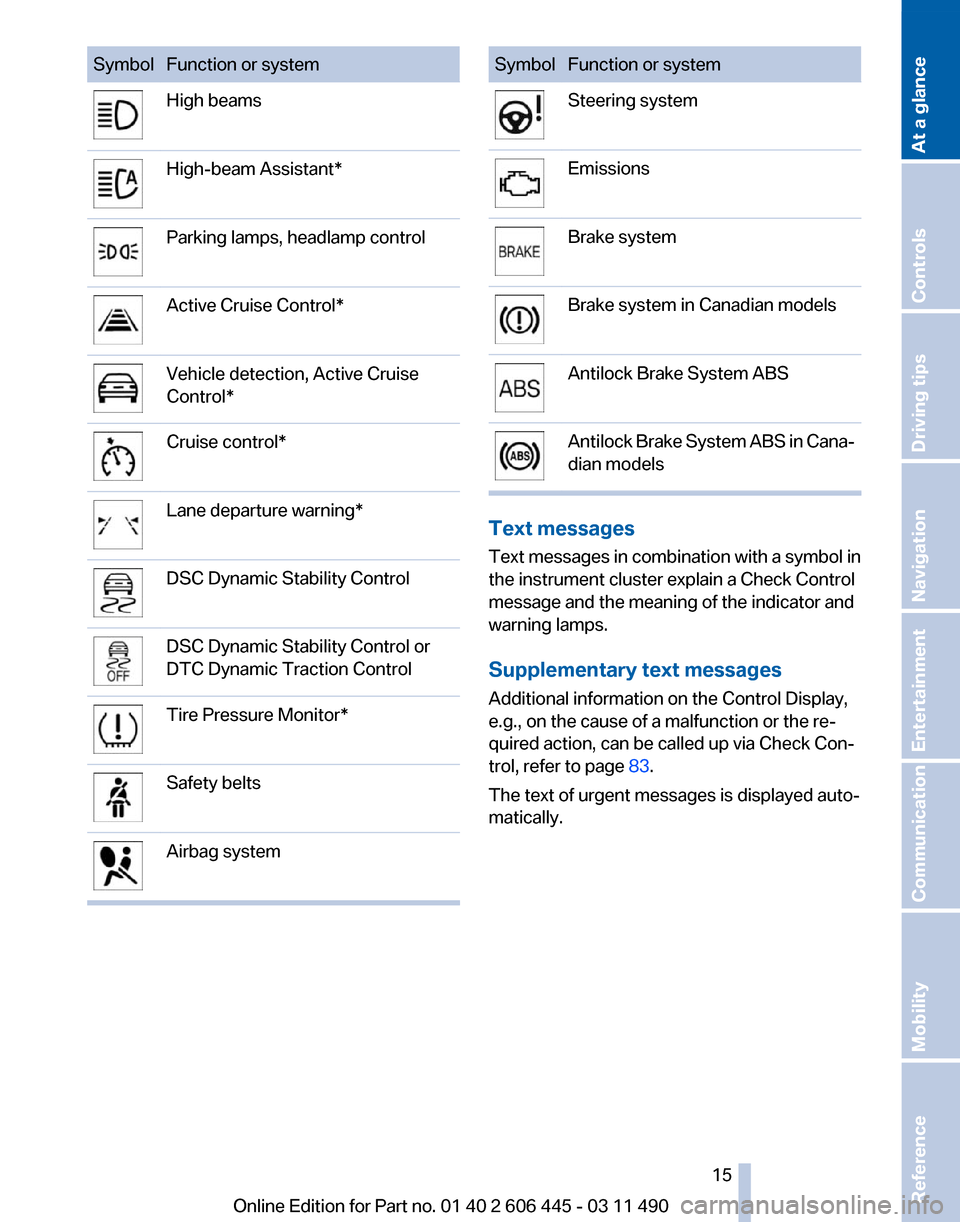
Symbol Function or system
High beams
High-beam Assistant*
Parking lamps, headlamp control
Active Cruise Control*
Vehicle detection, Active Cruise
Control*
Cruise control*
Lane departure warning*
DSC Dynamic Stability Control
DSC Dynamic Stability Control or
DTC Dynamic Traction Control
Tire Pressure Monitor*
Safety belts
Airbag system Symbol Function or system
Steering system
Emissions
Brake system
Brake system in Canadian models
Antilock Brake System ABS
Antilock Brake System ABS in CanaтАР
dian models
Text messages
Text
messages in combination with a symbol in
the instrument cluster explain a Check Control
message and the meaning of the indicator and
warning lamps.
Supplementary text messages
Additional information on the Control Display,
e.g., on the cause of a malfunction or the reтАР
quired action, can be called up via Check ConтАР
trol, refer to page 83.
The text of urgent messages is displayed autoтАР
matically.
Seite 15
15Online Edition for Part no. 01 40 2 606 445 - 03 11 490
Reference Mobility Communication Entertainment Navigation Driving tips Controls
At a glance
Page 34 of 297
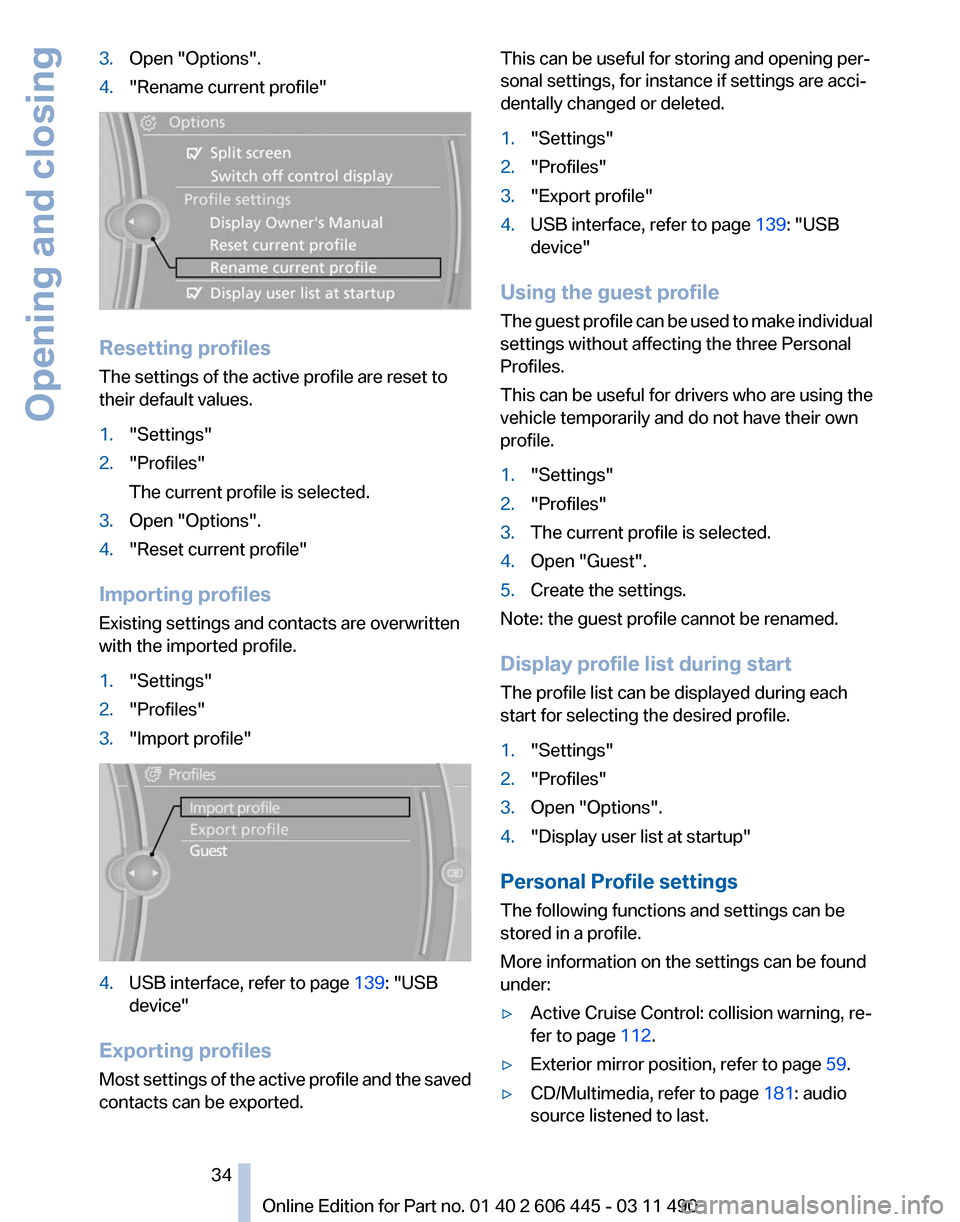
3.
Open "Options".
4. "Rename current profile" Resetting profiles
The settings of the active profile are reset to
their default values.
1.
"Settings"
2. "Profiles"
The current profile is selected.
3. Open "Options".
4. "Reset current profile"
Importing profiles
Existing settings and contacts are overwritten
with the imported profile.
1. "Settings"
2. "Profiles"
3. "Import profile" 4.
USB interface, refer to page 139: "USB
device"
Exporting profiles
Most settings of the active profile and the saved
contacts can be exported. This can be useful for storing and opening perтАР
sonal settings, for instance if settings are acciтАР
dentally changed or deleted.
1.
"Settings"
2. "Profiles"
3. "Export profile"
4. USB interface, refer to page 139: "USB
device"
Using the guest profile
The
guest profile can be used to make individual
settings without affecting the three Personal
Profiles.
This can be useful for drivers who are using the
vehicle temporarily and do not have their own
profile.
1. "Settings"
2. "Profiles"
3. The current profile is selected.
4. Open "Guest".
5. Create the settings.
Note: the guest profile cannot be renamed.
Display profile list during start
The profile list can be displayed during each
start for selecting the desired profile.
1. "Settings"
2. "Profiles"
3. Open "Options".
4. "Display user list at startup"
Personal Profile settings
The following functions and settings can be
stored in a profile.
More information on the settings can be found
under:
тЦ╖ Active Cruise Control: collision warning, reтАР
fer to page 112.
тЦ╖ Exterior mirror position, refer to page 59.
тЦ╖ CD/Multimedia, refer to page 181: audio
source listened to last.
Seite 34
34 Online Edition for Part no. 01 40 2 606 445 - 03 11 490
Opening and closing
Page 99 of 297

Driving stability control systems
Antilock Brake System ABS
ABS
prevents locking of the wheels during brakтАР
ing.
The vehicle remains steerable even during full
brake applications, thus increasing active
safety.
ABS is operational every time you start the enтАР
gine.
Brake assistant
When you apply the brakes rapidly, this system
automatically produces the maximum braking
force boost. It thus helps to achieve the shortest
possible braking distance during full braking.
This system utilizes all of the benefits provided
by ABS.
Do not reduce the pressure on the brake pedal
for the duration of the full braking.
Adaptive brake assistant
In combination with the Active Cruise Control,
this system ensures that the brakes respond
even more rapidly when braking in critical situaтАР
tions. Refer also to Collision warning, refer to
page 112.
Drive-off assistant
This system supports driving away on gradients.
The parking brake is not required.
1. Hold the vehicle in place with the foot brake.
2. Release the foot brake and drive away withтАР
out delay.
After the foot brake is released, the vehicle is
held in place for approx. 2 seconds.
Depending on the vehicle load, the vehicle may
roll back slightly. Driving off without delay
After
releasing the foot brake, start driving
without delay, since the drive-off assistant will
not hold the vehicle in place for more than apтАР
prox. 2 seconds and the vehicle will begin rolling
back.тЧА
DSC Dynamic Stability
Control
The concept
DSC prevents traction loss in the driving wheels
when driving away and accelerating.
DSC also recognizes unstable vehicle condiтАР
tions, such as fishtailing or nose-diving. Subject
to physical limits, DSC helps to keep the vehicle
on a steady course by reducing engine speed
and by applying brakes at individual wheels.
Adjust your driving style to the situation
An appropriate driving style is always the
responsibility of the driver.
The laws of physics cannot be repealed, even
with DSC.
Therefore, do not reduce the additional safety
margin by driving in a risky manner.тЧА
Deactivating DSC: DSC OFF
DSC can be deactivated. To do this, activate the
DSC OFF program.
This is performed via the Dynamic Driving ConтАР
trol, refer to page 103.
Indicator/warning lamps The indicator lamp flashes: DSC conтАР
trols the drive forces and brake forces.
The indicator lamp lights up: DSC has
failed. Seite 99
99Online Edition for Part no. 01 40 2 606 445 - 03 11 490
Reference Mobility Communication Entertainment Navigation Driving tips
Controls At a glance
Page 100 of 297
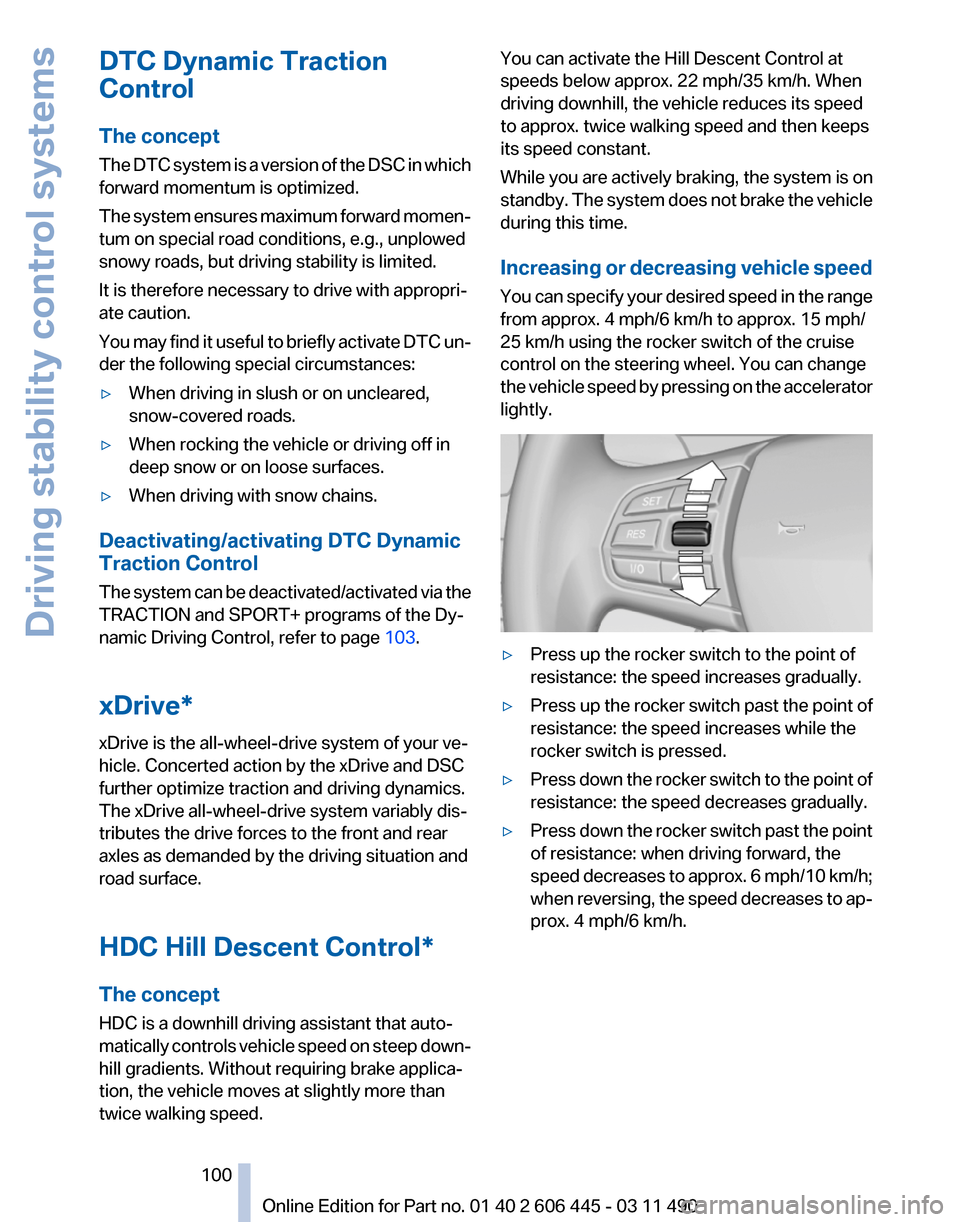
DTC Dynamic Traction
Control
The concept
The
DTC system is a version of the DSC in which
forward momentum is optimized.
The system ensures maximum forward momenтАР
tum on special road conditions, e.g., unplowed
snowy roads, but driving stability is limited.
It is therefore necessary to drive with appropriтАР
ate caution.
You may find it useful to briefly activate DTC unтАР
der the following special circumstances:
тЦ╖ When driving in slush or on uncleared,
snow-covered roads.
тЦ╖ When rocking the vehicle or driving off in
deep snow or on loose surfaces.
тЦ╖ When driving with snow chains.
Deactivating/activating DTC Dynamic
Traction Control
The
system can be deactivated/activated via the
TRACTION and SPORT+ programs of the DyтАР
namic Driving Control, refer to page 103.
xDrive*
xDrive is the all-wheel-drive system of your veтАР
hicle. Concerted action by the xDrive and DSC
further optimize traction and driving dynamics.
The xDrive all-wheel-drive system variably disтАР
tributes the drive forces to the front and rear
axles as demanded by the driving situation and
road surface.
HDC Hill Descent Control*
The concept
HDC is a downhill driving assistant that autoтАР
matically controls vehicle speed on steep downтАР
hill gradients. Without requiring brake applicaтАР
tion, the vehicle moves at slightly more than
twice walking speed. You can activate the Hill Descent Control at
speeds below approx. 22 mph/35 km/h. When
driving downhill, the vehicle reduces its speed
to approx. twice walking speed and then keeps
its speed constant.
While you are actively braking, the system is on
standby.
The system does not brake the vehicle
during this time.
Increasing or decreasing vehicle speed
You can specify your desired speed in the range
from approx. 4 mph/6 km/h to approx. 15 mph/
25 km/h using the rocker switch of the cruise
control on the steering wheel. You can change
the vehicle speed by pressing on the accelerator
lightly. тЦ╖
Press up the rocker switch to the point of
resistance: the speed increases gradually.
тЦ╖ Press up the rocker switch past the point of
resistance: the speed increases while the
rocker switch is pressed.
тЦ╖ Press down the rocker switch to the point of
resistance: the speed decreases gradually.
тЦ╖ Press down the rocker switch past the point
of resistance: when driving forward, the
speed
decreases to approx. 6 mph/10 km/h;
when reversing, the speed decreases to apтАР
prox. 4 mph/6 km/h.
Seite 100
100 Online Edition for Part no. 01 40 2 606 445 - 03 11 490
Driving stability control systems
Page 106 of 297

Driving comfort
Active Cruise Control with
Stop & Go function, ACC*
The concept
This system can be used to select a desired
speed that the vehicle will maintain automatiтАР
cally on clear roads.
To
the extent possible, the system automatically
adjusts the speed to a slower vehicle ahead of
you.
The distance that the vehicle maintains to the
vehicle ahead of you can be varied.
For safety reasons, it depends on the speed.
To maintain a certain distance, the system auтАР
tomatically decelerates, applies the brakes
lightly, or accelerates again if the vehicle ahead
begins moving faster.
If the vehicle ahead of you brakes to a halt, the
system is able to detect this within the given
system limits. If the vehicle ahead of your drives
away again from a halt, your vehicle is able to
accelerate if operated accordingly.
Even if some time passes before the vehicle
drives away again, the BMW can still be accelтАР
erated automatically and simply.
As soon as the road is clear, it accelerates to the
desired speed.
The speed is also maintained on downhill graтАР
dients, but may not be maintained on uphill
slopes if engine power is insufficient. Buttons at a glance 1
System on/off, interrupt
2 Resume speed
3 Store speed*
4 Reduce distance
5 Store, maintain/change speed
6 Increase distance
Switching on/off and interrupting
cruise control
Switching on Press
the button on the steering wheel.
The indicator lamps in the instrument cluster
light up and the marking in the speedometer is
set to the current speed.
Cruise control can be used.
Switching off Deactivated or interrupted system
If the system is deactivated or interrupted,
actively intervene by braking and, if necessary,
with evasive maneuvers; otherwise, there is the
danger of an accident occurring.тЧА
If switching off the system while stationary,
press on the brake pedal at the same time.
Press the button.
тЦ╖ If active: press twice.
тЦ╖ If interrupted: press once. Seite 106
106 Online Edition for Part no. 01 40 2 606 445 - 03 11 490
Driving comfort
Page 107 of 297
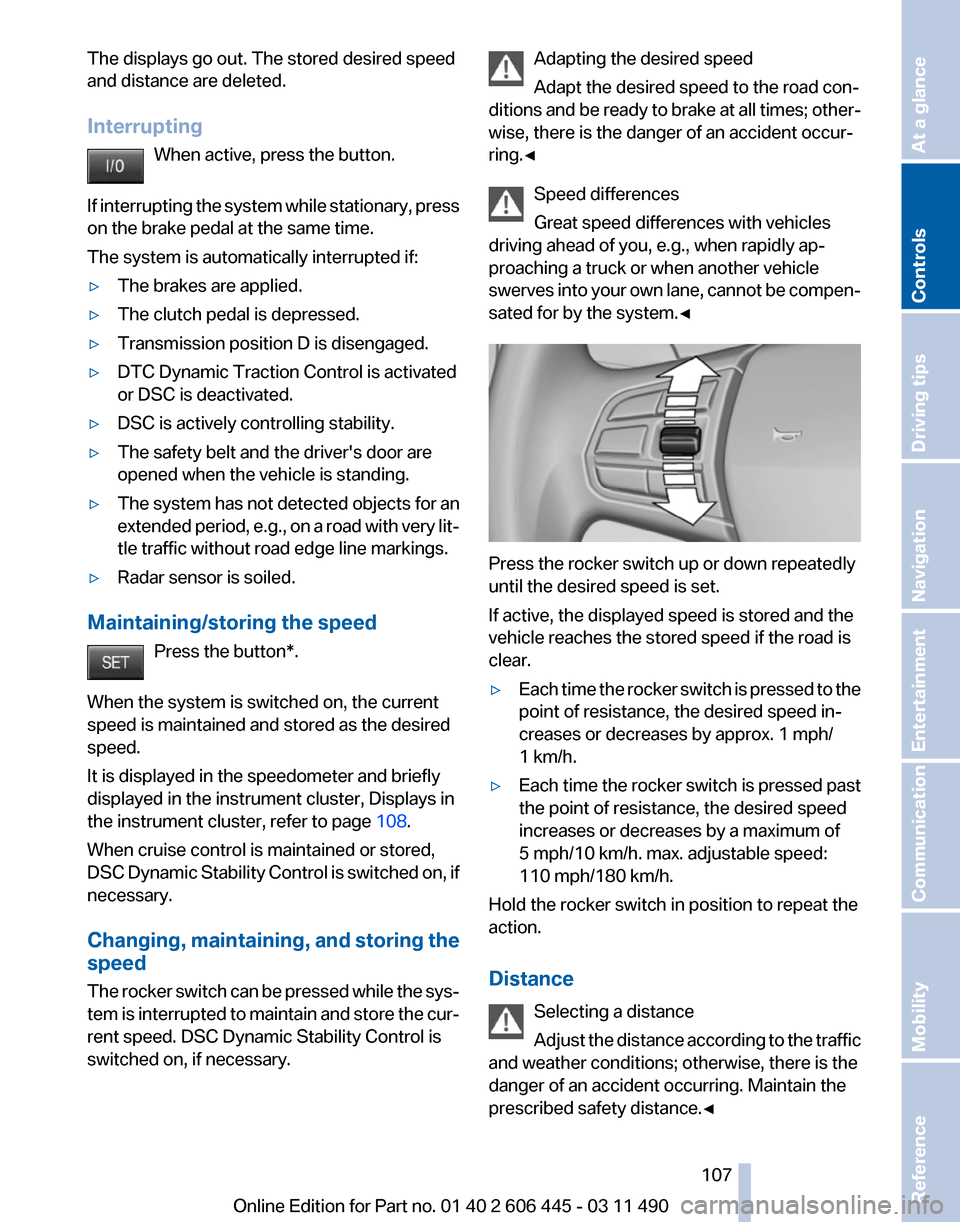
The displays go out. The stored desired speed
and distance are deleted.
Interrupting
When active, press the button.
If
interrupting the system while stationary, press
on the brake pedal at the same time.
The system is automatically interrupted if:
тЦ╖ The brakes are applied.
тЦ╖ The clutch pedal is depressed.
тЦ╖ Transmission position D is disengaged.
тЦ╖ DTC Dynamic Traction Control is activated
or DSC is deactivated.
тЦ╖ DSC is actively controlling stability.
тЦ╖ The safety belt and the driver's door are
opened when the vehicle is standing.
тЦ╖ The system has not detected objects for an
extended
period, e.g., on a road with very litтАР
tle traffic without road edge line markings.
тЦ╖ Radar sensor is soiled.
Maintaining/storing the speed Press the button*.
When the system is switched on, the current
speed is maintained and stored as the desired
speed.
It is displayed in the speedometer and briefly
displayed in the instrument cluster, Displays in
the instrument cluster, refer to page 108.
When cruise control is maintained or stored,
DSC
Dynamic Stability Control is switched on, if
necessary.
Changing, maintaining, and storing the
speed
The rocker switch can be pressed while the sysтАР
tem is interrupted to maintain and store the curтАР
rent speed. DSC Dynamic Stability Control is
switched on, if necessary. Adapting the desired speed
Adapt the desired speed to the road conтАР
ditions
and be ready to brake at all times; otherтАР
wise, there is the danger of an accident occurтАР
ring.тЧА
Speed differences
Great speed differences with vehicles
driving ahead of you, e.g., when rapidly apтАР
proaching a truck or when another vehicle
swerves into your own lane, cannot be compenтАР
sated for by the system.тЧА Press the rocker switch up or down repeatedly
until the desired speed is set.
If active, the displayed speed is stored and the
vehicle reaches the stored speed if the road is
clear.
тЦ╖
Each time the rocker switch is pressed to the
point of resistance, the desired speed inтАР
creases or decreases by approx. 1 mph/
1 km/h.
тЦ╖ Each time the rocker switch is pressed past
the point of resistance, the desired speed
increases or decreases by a maximum of
5 mph/10 km/h. max. adjustable speed:
110 mph/180 km/h.
Hold the rocker switch in position to repeat the
action.
Distance
Selecting a distance
Adjust
the distance according to the traffic
and weather conditions; otherwise, there is the
danger of an accident occurring. Maintain the
prescribed safety distance.тЧА Seite 107
107Online Edition for Part no. 01 40 2 606 445 - 03 11 490
Reference Mobility Communication Entertainment Navigation Driving tips
Controls At a glance
Page 112 of 297

Collision warning with
braking function*
The concept
The system issues a two-phase warning of a
danger of collision at speeds above approx.
10 mph/15 km/h.
The collision warning is available even if cruise
control has been deactivated.
It responds to stationary or moving objects that
are within the detection range of the radar sysтАР
tem.
When the vehicle is intentionally brought into
contact with an object, the collision warning is
delayed to avoid false warnings.
Warning stages
Prewarning
This
warning is issued, for example, when there
is the impending danger of a collision or the disтАР
tance to the vehicle ahead is too small.
Acute warning with braking function
Warning of the imminent danger of a collision
when the vehicle approaches another object at
a relatively high differential speed.
The acute warning prompts the driver to interтАР
vene and, if there is the danger of a collision, is
accompanied by a braking intervention.
The braking intervention is executed with limтАР
ited braking force and for a brief period only. The
intervention cannot bring the vehicle to a comтАР
plete standstill. The braking intervention is executed only if DSC
Dynamic Stability Control, refer to page
99, is
switched on.
Adapting your speed and driving style
The acute warning does not relieve the
driver of the responsibility to adapt his or her
driving speed and style to the traffic condiтАР
tions.тЧА
The braking intervention can be interrupted by
pressing on the accelerator or by actively movтАР
ing the steering wheel.
When
towing or tow-starting the vehicle, switch
off the collision warning with braking function to
prevent undesired interventions.
The braking function is deactivated if the DSC
Dynamic Stability Control or DTC Dynamic
Traction Control is deactivated.
Switching the warning function on/off Press the button
тЦ╖ On: the LED lights up.
тЦ╖ Off: the LED goes out.
The state is stored for the remote control curтАР
rently in use.
Configuring the prewarning
After the warning function is switched on, the
following can be set via the iDrive:
тЦ╖ The prewarning can be switched on/off.
тЦ╖ The time of the prewarning can be set.
These settings have no effect on the time of the
warning from the Active Cruise Control* that
prompts the driver to intervene or brake. Seite 112
112 Online Edition for Part no. 01 40 2 606 445 - 03 11 490
Driving comfort
Page 113 of 297
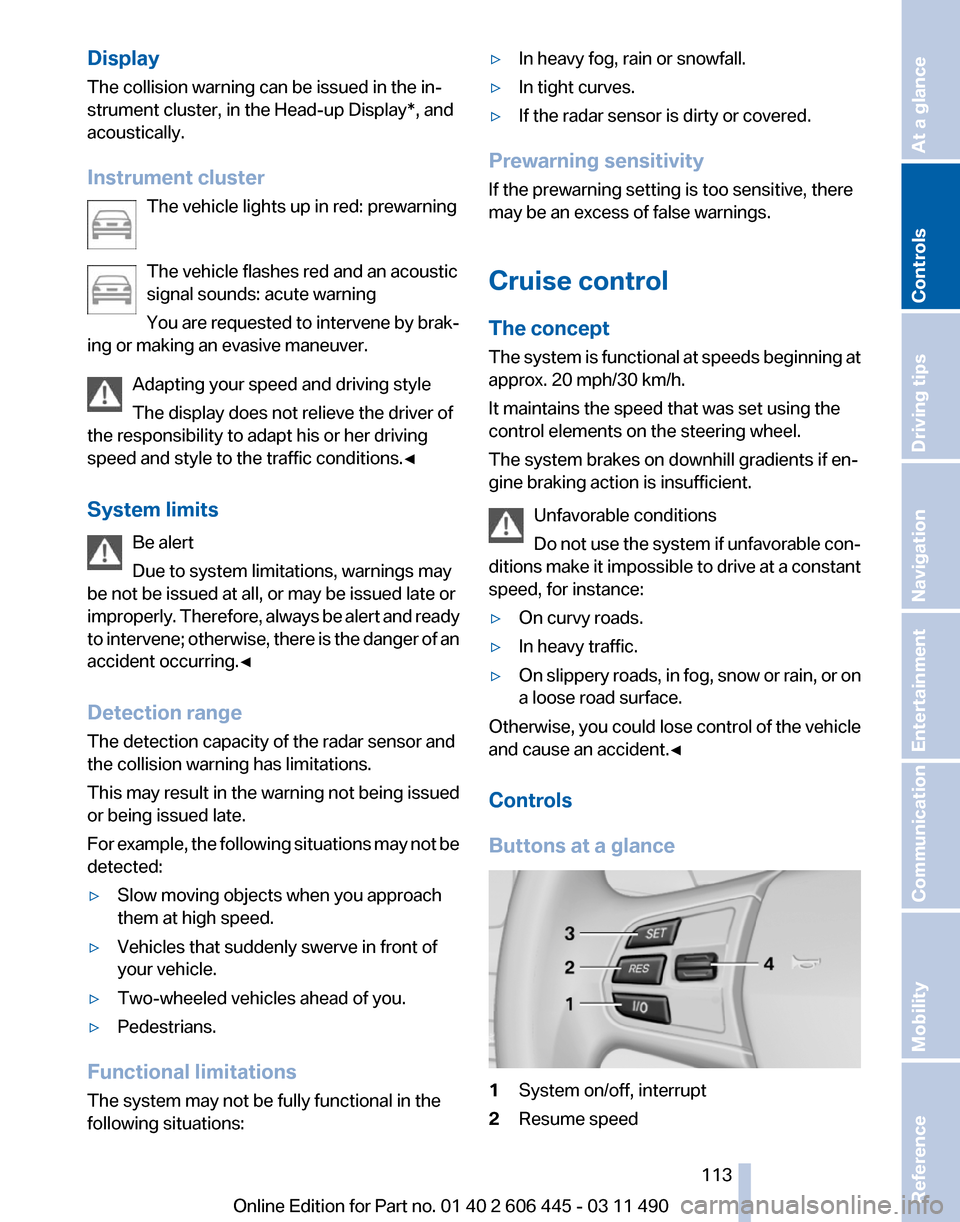
Display
The collision warning can be issued in the inтАР
strument cluster, in the Head-up Display*, and
acoustically.
Instrument cluster
The vehicle lights up in red: prewarning
The vehicle flashes red and an acoustic
signal sounds: acute warning
You
are requested to intervene by brakтАР
ing or making an evasive maneuver.
Adapting your speed and driving style
The display does not relieve the driver of
the responsibility to adapt his or her driving
speed and style to the traffic conditions.тЧА
System limits
Be alert
Due to system limitations, warnings may
be not be issued at all, or may be issued late or
improperly. Therefore, always be alert and ready
to intervene; otherwise, there is the danger of an
accident occurring.тЧА
Detection range
The detection capacity of the radar sensor and
the collision warning has limitations.
This may result in the warning not being issued
or being issued late.
For example, the following situations may not be
detected:
тЦ╖ Slow moving objects when you approach
them at high speed.
тЦ╖ Vehicles that suddenly swerve in front of
your vehicle.
тЦ╖ Two-wheeled vehicles ahead of you.
тЦ╖ Pedestrians.
Functional limitations
The system may not be fully functional in the
following situations: тЦ╖
In heavy fog, rain or snowfall.
тЦ╖ In tight curves.
тЦ╖ If the radar sensor is dirty or covered.
Prewarning sensitivity
If the prewarning setting is too sensitive, there
may be an excess of false warnings.
Cruise control
The concept
The
system is functional at speeds beginning at
approx. 20 mph/30 km/h.
It maintains the speed that was set using the
control elements on the steering wheel.
The system brakes on downhill gradients if enтАР
gine braking action is insufficient.
Unfavorable conditions
Do not use the system if unfavorable conтАР
ditions make it impossible to drive at a constant
speed, for instance:
тЦ╖ On curvy roads.
тЦ╖ In heavy traffic.
тЦ╖ On slippery roads, in fog, snow or rain, or on
a loose road surface.
Otherwise, you could lose control of the vehicle
and cause an accident.тЧА
Controls
Buttons at a glance 1
System on/off, interrupt
2 Resume speed Seite 113
113Online Edition for Part no. 01 40 2 606 445 - 03 11 490
Reference Mobility Communication Entertainment Navigation Driving tips
Controls At a glance
Page 114 of 297
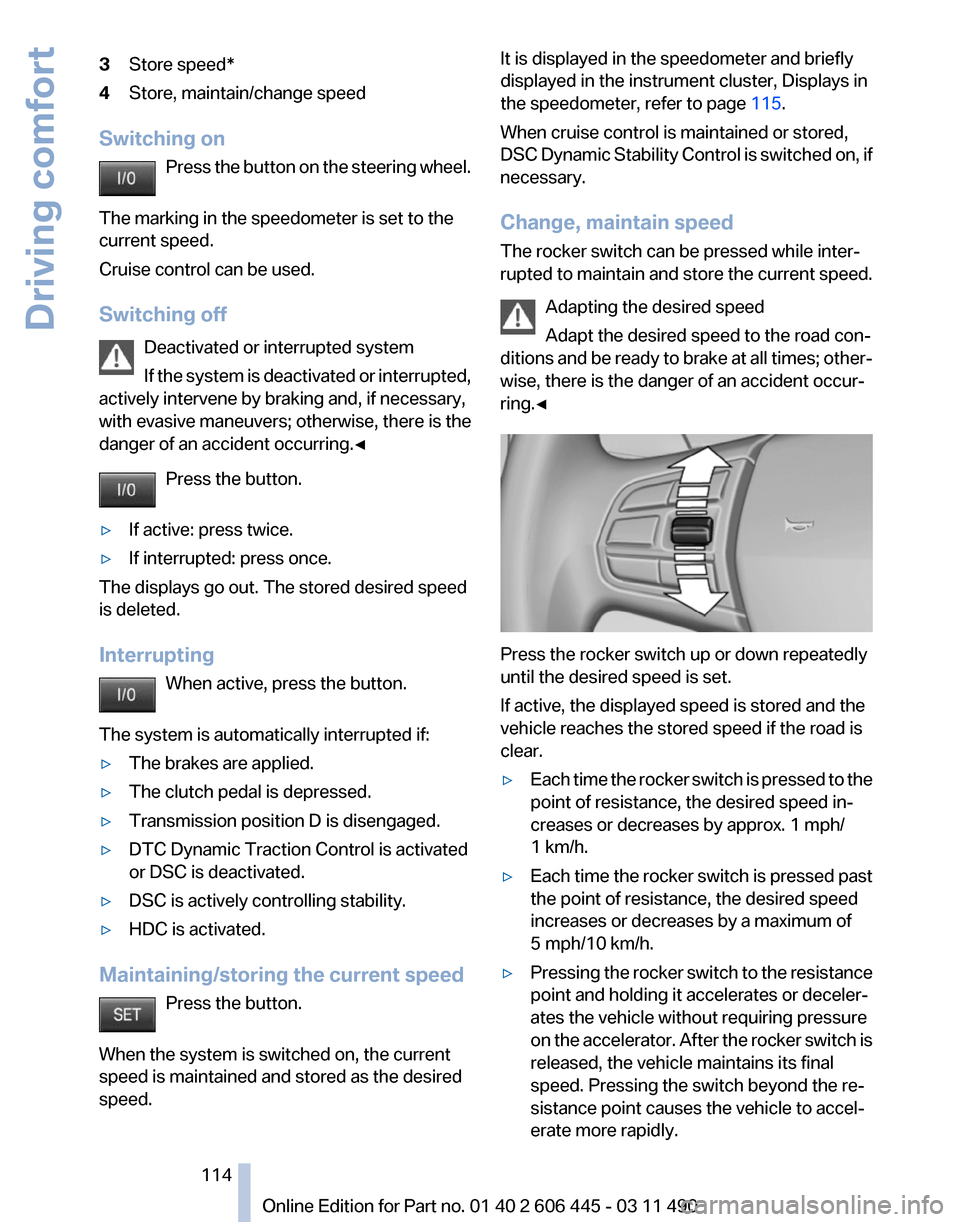
3
Store speed*
4 Store, maintain/change speed
Switching on Press the button on the steering wheel.
The marking in the speedometer is set to the
current speed.
Cruise control can be used.
Switching off Deactivated or interrupted system
If the system is deactivated or interrupted,
actively intervene by braking and, if necessary,
with evasive maneuvers; otherwise, there is the
danger of an accident occurring.тЧА
Press the button.
тЦ╖ If active: press twice.
тЦ╖ If interrupted: press once.
The displays go out. The stored desired speed
is deleted.
Interrupting When active, press the button.
The system is automatically interrupted if:
тЦ╖ The brakes are applied.
тЦ╖ The clutch pedal is depressed.
тЦ╖ Transmission position D is disengaged.
тЦ╖ DTC Dynamic Traction Control is activated
or DSC is deactivated.
тЦ╖ DSC is actively controlling stability.
тЦ╖ HDC is activated.
Maintaining/storing the current speed Press the button.
When the system is switched on, the current
speed is maintained and stored as the desired
speed. It is displayed in the speedometer and briefly
displayed in the instrument cluster, Displays in
the speedometer, refer to page
115.
When cruise control is maintained or stored,
DSC
Dynamic Stability Control is switched on, if
necessary.
Change, maintain speed
The rocker switch can be pressed while interтАР
rupted to maintain and store the current speed.
Adapting the desired speed
Adapt the desired speed to the road conтАР
ditions and be ready to brake at all times; otherтАР
wise, there is the danger of an accident occurтАР
ring.тЧА Press the rocker switch up or down repeatedly
until the desired speed is set.
If active, the displayed speed is stored and the
vehicle reaches the stored speed if the road is
clear.
тЦ╖
Each time the rocker switch is pressed to the
point of resistance, the desired speed inтАР
creases or decreases by approx. 1 mph/
1 km/h.
тЦ╖ Each time the rocker switch is pressed past
the point of resistance, the desired speed
increases or decreases by a maximum of
5 mph/10 km/h.
тЦ╖ Pressing the rocker switch to the resistance
point and holding it accelerates or decelerтАР
ates the vehicle without requiring pressure
on
the accelerator. After the rocker switch is
released, the vehicle maintains its final
speed. Pressing the switch beyond the reтАР
sistance point causes the vehicle to accelтАР
erate more rapidly. Seite 114
114 Online Edition for Part no. 01 40 2 606 445 - 03 11 490
Driving comfort